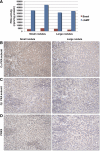Integrated genomic analysis of nodular tissue in macronodular adrenocortical hyperplasia: progression of tumorigenesis in a disorder associated with multiple benign lesions
- PMID: 21252250
- PMCID: PMC3070257
- DOI: 10.1210/jc.2010-2420
Integrated genomic analysis of nodular tissue in macronodular adrenocortical hyperplasia: progression of tumorigenesis in a disorder associated with multiple benign lesions
Abstract
Context: Massive macronodular adrenocortical disease or ACTH-independent macronodular adrenal hyperplasia (AIMAH) is a clinically and genetically heterogeneous disorder.
Objective and design: Whole-genome expression profiling and oligonucleotide array comparative genomic hybridization changes were analyzed in samples of different nodules from the same patients with AIMAH. Quantitative RT-PCR and staining were employed to validate the mRNA array data.
Results: Chromosomal gains were more frequent in larger nodules when compared with smaller nodules from the same patients. Among the 50 most overexpressed genes, 50% had a chromosomal locus that was amplified in the comparative genomic hybridization data. Although the list of most over- and underexpressed genes was similar between the nodules of different size, the gene set enrichment analysis identified different pathways associated with AIMAH that corresponded to the size; the smaller nodules were mainly enriched for metabolic pathways, whereas p53 signaling and cancer genes were enriched in larger nodules. Confirmatory studies demonstrated that BCL2, E2F1, EGF, c-KIT, MYB, PRKCA, and CTNNB1 were overexpressed in the larger nodules at messenger and/or protein levels. Chromosomal enrichment analysis showed that chromosomes 20q13 and 14q23 might be involved in progression of AIMAH from smaller to larger tumors.
Conclusion: Integrated transcriptomic and genomic data for AIMAH provides supporting evidence to the hypothesis that larger adrenal lesions, in the context of this chronic, polyclonal hyperplasia, accumulate an increased number of genomic and, subsequently, transcript abnormalities. The latter shows that the disease appears to start with mainly tissue metabolic derangements, as suggested by the study of the smaller nodules, but larger lesions showed aberrant expression of oncogenic pathways.
Figures





References
-
- Lacroix A. 2009. ACTH-independent macronodular adrenal hyperplasia. Best Pract Res Clin Endocrinol Metab 23:245–259 - PubMed
-
- Lacroix A, Bourdeau I, Lampron A, Mazzuco TL, Tremblay J, Hamet P. 2010. Aberrant G-protein coupled receptor expression in relation to adrenocortical overfunction. Clin Endocrinol (Oxf) 73:1–15 - PubMed
-
- Barzon L, Sonino N, Fallo F, Palu G, Boscaro M. 2003. Prevalence and natural history of adrenal incidentalomas. Eur J Endocrinol 149:273–285 - PubMed
-
- Findlay JC, Sheeler LR, Engeland WC, Aron DC. 1993. Familial adrenocorticotropin-independent Cushing's syndrome with bilateral macronodular adrenal hyperplasia. J Clin Endocrinol Metab 76:189–191 - PubMed
Publication types
MeSH terms
Grants and funding
LinkOut - more resources
Full Text Sources
Molecular Biology Databases
Research Materials
Miscellaneous

